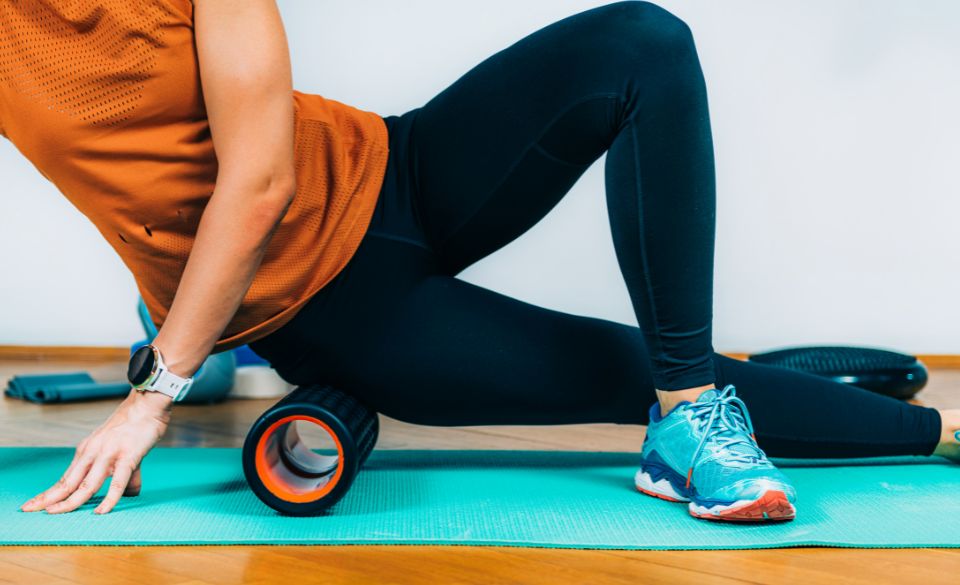
Rolling Toward Recovery: The Best Foam Rolling Exercises for Runners
Page Contents
- Why Foam Rolling? The Science Behind the Technique
- 1. Quadriceps Roll: Tackling Front-of-Thigh Tension
- 2. IT Band Roll: Addressing Outer Leg Tightness
- 3. Hamstring Roll: Easing Posterior Tightness
- 4. Calf Roll: Relaxing Lower Leg Muscles
- 5. Glute Roll: Targeting Hip and Gluteal Tension
- 6. Thoracic Spine Roll: Enhancing Upper Back Mobility
- 7. Plantar Fascia Roll: Caring for Your Feet
- Incorporating Foam Rolling into Your Routine: Tips for Success
- Taking Your Foam Rolling to the Next Level: Advanced Techniques and Tips
- Foam Rolling Beyond the Basics: Tailoring Your Routine to Your Needs
- Conclusion: Roll Your Way to Running Success
As runners, we’re no strangers to the joy and satisfaction that come with conquering miles and pushing our limits. But along with the thrill of the run, our bodies often endure the wear and tear of the road. That’s where foam rolling steps in – a simple yet effective technique that can work wonders in helping us recover, prevent injuries, and keep us moving smoothly on our running journey. Let’s dive into the world of foam rolling and explore the best exercises that every runner should have in their recovery toolkit.
Why Foam Rolling? The Science Behind the Technique
Before we delve into the specific exercises, let’s understand why foam rolling holds a special place in a runner’s recovery routine. Foam rolling is a form of self-myofascial release, which involves applying pressure to specific points on your muscles to alleviate tension, improve blood flow, and enhance overall flexibility. This technique mimics the benefits of a deep tissue massage, helping to break up knots, release trigger points, and keep your muscles and fascia in optimal condition.
A study published in the Journal of Athletic Training explored the effects of foam rolling on muscle soreness and range of motion. The findings revealed that foam rolling significantly reduced muscle soreness and led to improvements in joint flexibility. This highlights the potential of foam rolling as a valuable tool for runners seeking to enhance their recovery and maintain peak performance.
1. Quadriceps Roll: Tackling Front-of-Thigh Tension
The quadriceps, those powerful muscles at the front of your thighs, play a crucial role in running. To perform the Quadriceps Roll, start by lying face down and positioning the foam roller under your thighs. Use your arms to support your upper body as you roll back and forth from your hips to just above your knees. This exercise targets the quads and can help alleviate tightness that often arises from uphill or intense running sessions.
2. IT Band Roll: Addressing Outer Leg Tightness
The iliotibial (IT) band, a thick band of connective tissue running along the outer side of your thigh, can become tight and cause discomfort for runners. To target this area, lie on your side with the foam roller positioned beneath your outer thigh. Use your arms and supporting leg to control the pressure as you roll from your hip down to just above your knee. The IT Band Roll can help release tension and maintain healthy IT band function.
3. Hamstring Roll: Easing Posterior Tightness
The hamstrings, located at the back of your thighs, can often feel tight after a run. To address this, sit on the foam roller with your legs extended and your hands behind you for support. Roll back and forth along your hamstrings, focusing on any areas of tension. This exercise aids in increasing blood flow to the hamstrings and can contribute to improved flexibility.
4. Calf Roll: Relaxing Lower Leg Muscles
The calf muscles are vital for propelling your running stride. To target the calves, sit on the floor with the foam roller positioned under your lower leg. Cross one leg over the other to increase pressure and roll from your ankle to just below your knee. This exercise can help alleviate tightness in the calf muscles, making it a valuable addition to your post-run routine.
5. Glute Roll: Targeting Hip and Gluteal Tension
Your gluteal muscles, including the gluteus maximus and medius, play a crucial role in stabilizing your pelvis and supporting your running stride. To address tension in this area, sit on the foam roller with your hands behind you and your feet flat on the floor. Cross one ankle over the opposite knee and shift your weight onto the side of the crossed leg. Roll back and forth, focusing on the outer hip and glute muscles. This exercise can help release tightness and improve hip mobility.
6. Thoracic Spine Roll: Enhancing Upper Back Mobility
Running isn’t just about your legs; your upper body posture and mobility also contribute to efficient running mechanics. The Thoracic Spine Roll can help alleviate tension and improve flexibility in your upper back. Lie on your back with the foam roller placed horizontally beneath your upper back. Support your head with your hands and gently roll back and forth, targeting the area between your shoulder blades. This exercise promotes healthy thoracic spine movement and can contribute to better posture during your runs.
7. Plantar Fascia Roll: Caring for Your Feet
Last but certainly not least, let’s not forget about your feet – the foundation of your running journey. To target the plantar fascia, a band of tissue that runs along the bottom of your foot, sit on a chair and place the foam roller under your foot. Gently roll back and forth from your heel to the ball of your foot, applying controlled pressure. This exercise can help alleviate tightness and discomfort in the plantar fascia, a common issue among runners.
Incorporating Foam Rolling into Your Routine: Tips for Success
To make the most of your foam rolling experience, consider these tips:
Consistency is Key: Incorporate foam rolling into your routine on a regular basis. Even a few minutes after each run can make a significant difference in your recovery.
Breathe and Relax: While foam rolling can be intense, remember to breathe deeply and relax your muscles as you roll. Avoid holding your breath or tensing up.
Target Specific Areas: Focus on areas that feel tight or sore, but don’t neglect other muscle groups. Maintaining balance in your foam rolling routine is important for overall muscle health.
Gradually Increase Pressure: Start with gentle pressure and gradually increase as your muscles become accustomed to the sensation. It’s important to find a balance between discomfort and pain.
Stay Hydrated: Hydrated muscles respond better to foam rolling. Drink water before and after your session to support muscle function and recovery.
Taking Your Foam Rolling to the Next Level: Advanced Techniques and Tips
Congratulations, you’re well on your way to becoming a foam rolling pro! Now that you’ve mastered the basics, let’s explore some advanced foam rolling techniques and tips that can further elevate your recovery and keep you running strong.
1. Dynamic Foam Rolling: Mobilizing Muscles
Dynamic foam rolling involves adding movement to your foam rolling routine. Instead of simply rolling back and forth, incorporate controlled movements that mimic the motions of running. For example, when targeting your quadriceps, roll while bending and straightening your knee. This dynamic approach helps mobilize muscles and joints while improving flexibility and enhancing your range of motion – all crucial elements for a runner’s performance.
2. Trigger Point Release: Pinpointing Tight Spots
If you’ve ever experienced a particularly stubborn knot or trigger point, trigger point release techniques can provide targeted relief. To perform trigger point release, position the foam roller directly over the tight spot. Apply sustained pressure to the area for about 30 seconds, allowing the muscle to release and relax. This technique can be intense, so listen to your body and adjust the pressure as needed.
3. Lateral Line Roll: Addressing Lateral Tightness
The lateral line roll targets the muscles on the side of your body, including the obliques and the lats. Lie on your side with the foam roller placed beneath your armpit and your arm extended overhead. Roll along the side of your body, from your armpit to your hip. This technique can help release tension and improve lateral mobility, which is essential for efficient running mechanics.
4. Piriformis Roll: Easing Hip Discomfort
The piriformis muscle, located deep within your glutes, can contribute to hip discomfort and even sciatic nerve irritation. To target the piriformis, sit on the foam roller with one ankle crossed over the opposite knee. Shift your weight onto the crossed leg and roll back and forth. This technique can provide relief for runners dealing with hip tightness or discomfort.
Foam Rolling Beyond the Basics: Tailoring Your Routine to Your Needs
As you continue your exploration of advanced foam rolling techniques, it’s important to customize your routine based on your individual needs and goals. Each runner’s body is unique, and understanding how to tailor your foam rolling practice can make a significant difference in your overall recovery and performance. Let’s delve into the art of personalizing your foam rolling routine.
1. Duration and Frequency: Finding Your Balance
The duration and frequency of your foam rolling sessions can vary based on factors such as your running intensity, training volume, and recovery needs. While some runners benefit from shorter, daily sessions, others may prefer longer sessions a few times a week. Listen to your body and adjust your routine accordingly. Remember, consistency is key, so find a balance that works for you and your schedule.
2. Targeted Approach: Addressing Specific Concerns
Take a targeted approach by focusing on specific areas that require attention. If you frequently experience tightness in your calves, dedicate more time to rolling out that area. Alternatively, if you’re preparing for a hilly race, prioritize rolling your quadriceps and hip flexors. Identifying your body’s unique patterns of tension and discomfort allows you to tailor your foam rolling routine to your running goals.
3. Pre-Run Activation: Warming Up with Foam Rolling
Foam rolling isn’t limited to post-run recovery; it can also serve as an effective warm-up tool. Incorporate foam rolling into your pre-run routine by performing dynamic foam rolling exercises that engage the muscles you’ll be using during your run. This approach not only prepares your muscles for the workout ahead but also enhances your mobility and range of motion.
4. Listen to Feedback: Your Body Knows Best
Your body is an expert communicator, providing feedback through sensations of discomfort or relief during foam rolling. Pay attention to how your muscles respond to different techniques and pressure levels. If an area feels particularly tender, spend extra time on it. If you experience pain or discomfort that persists, consult a healthcare professional to ensure you’re using proper technique and addressing any underlying issues.
Conclusion: Roll Your Way to Running Success
As you lace up your running shoes and embark on your next adventure, remember that your foam roller is a powerful ally in your pursuit of running success. By incorporating these best foam rolling exercises into your routine, you’re taking proactive steps to enhance your recovery, prevent injuries, and optimize your running performance. From your quadriceps to your calves, and from your glutes to your feet, each roll is a gesture of care and commitment to your body’s well-being.




